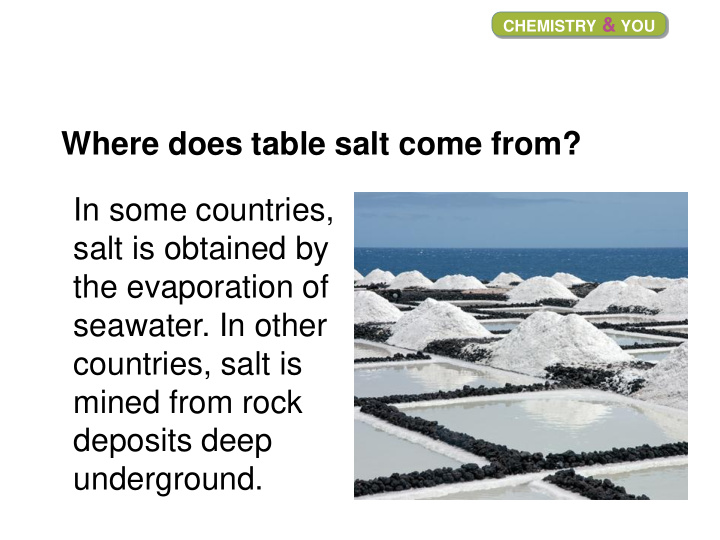



CHEMISTRY & YOU Where does table salt come from? In some countries, salt is obtained by the evaporation of seawater. In other countries, salt is mined from rock deposits deep underground.
Formation of Ionic Compounds Sodium chloride, or table salt, is an ionic compound consisting of sodium cations and chloride anions. • An ionic compound is a compound composed of cations and anions.
Formation of Ionic Compounds Although they are composed of ions, ionic compounds are electrically neutral. • The total positive charge of the cations equals the total negative charge of the anions.
Formation of Ionic Compounds Ionic Bonds Anions and cations have opposite charges and attract one another by means of electrostatic forces. • The electrostatic forces that hold ions together in ionic compounds are called ionic bonds .
Formation of Ionic Compounds Ionic Bonds When sodium and chlorine react to form a compound, the sodium atom transfers its one valence electron to the chlorine atom. • Sodium and chlorine atoms combine in a one-to- one ratio, and both ions have stable octets.
Formation of Ionic Compounds Formula Units A chemical formula shows the numbers of atoms of each element in the smallest representative unit of a substance. • NaCl is the chemical formula for sodium chloride.
Formation of Ionic Compounds Formula Units Ionic compounds do not exist as discrete units, but as collections of positively and negatively charged ions arranged in repeating patterns.
Formation of Ionic Compounds Formula Units The chemical formula of an ionic compound refers to a ratio known as a formula unit. • A formula unit is the lowest whole- number ratio of ions in an ionic compound.
Formation of Ionic Compounds Formula Units For sodium chloride, the lowest whole- number ratio of the ions is 1:1 (one Na + ion to each Cl – ion). • The formula unit for sodium chloride is NaCl. • Although ionic charges are used to derive the correct formula, they are not shown when you write the formula unit of the compound.
Predicting Formulas of Ionic Compounds Use electron dot structures to predict the formulas of the ionic compounds formed from the following elements: a. potassium and oxygen b. magnesium and nitrogen
Solve Apply the concepts to this problem. a. In order to have a completely filled valence shell, the oxygen atom must gain two electrons. These electrons come from two potassium atoms, each of which loses one electron. K • K + 2 – • • • • O • • • • O • • + • • • • K • K +
Solve Apply the concepts to this problem. a. Express the electron dot structure as a formula. • The formula of the compound formed is K 2 O (potassium oxide).
Solve Apply the concepts to this problem. 2 b. Start with the atoms. • • • • Mg and N • • •
Solve Apply the concepts to this problem. b. Each nitrogen atom needs three electrons to have an octet, but each magnesium atom can lose only two electrons. Three magnesium atoms are needed for every two nitrogen atoms. • 3 – Mg • • • Mg 2+ • N • • • • N • • • • • • • Mg Mg 2+ + • 3 – • • • N • • • • • • N • • • • • Mg Mg 2+ •
Solve Apply the concepts to this problem. b. Express the electron dot structure as a formula. • The formula of the compound formed is Mg 3 N 2 (magnesium nitride).
Use electron dot structures to determine the formula of the ionic compound formed when calcium reacts with fluorine.
Use electron dot structures to determine the formula of the ionic compound formed when calcium reacts with fluorine. – • • • • • • F • • • • F • • • • • • Ca 2+ Ca + – • • • • • • • F • • • • F • • • • • CaF 2
Properties of Ionic Compounds What are three properties of ionic compounds? Most ionic compounds are crystalline solids at room temperature. Each ion is attracted strongly to each of its neighbors, and repulsions are minimized. Ionic compounds generally have high melting points.
Properties of Ionic Compounds Ionic compounds can conduct an electric current when melted or dissolved in water.
Properties of Ionic Compounds When sodium chloride is melted, the orderly crystal structure breaks down. Power source Current meter • If a voltage is Flow of electrons applied across Flow of Inert metal electrons this molten electrodes Cl – mass, cations Na + migrate freely to one electrode and anions migrate to the other. To ( – ) To (+) electrode electrode • This movement of electrons allows electric current to flow between the electrodes through an external wire.
Properties of Ionic Compounds This solar facility uses molten NaCl for its ability to absorb and hold a large quantity of heat, which is used to generate electricity.
Properties of Ionic Compounds Ionic compounds also conduct electric current if they are dissolved in water. • When dissolved, the ions are free to move about in the solution.
When can ionic compounds conduct an electric current? A. Only when melted B. When melted or dissolved in water C. Only when dissolved in water D. When solid or melted
Key Concepts Although they are composed of ions, ionic compounds are electrically neutral. Most ionic compounds are crystalline solids at room temperature. Ionic compounds generally have high melting points. Ionic compounds can conduct an electric current when melted or dissolved in water.
Glossary Terms • ionic compound: a compound composed of positive and negative ions • ionic bond: the electrostatic attraction that binds oppositely charged ions together • chemical formula: an expression that indicates the number and type of atoms present in the smallest representative unit of a substance
Recommend
More recommend